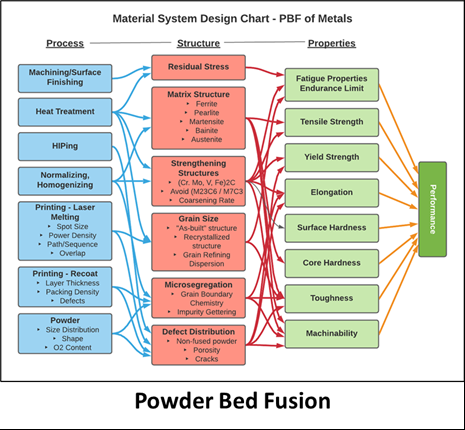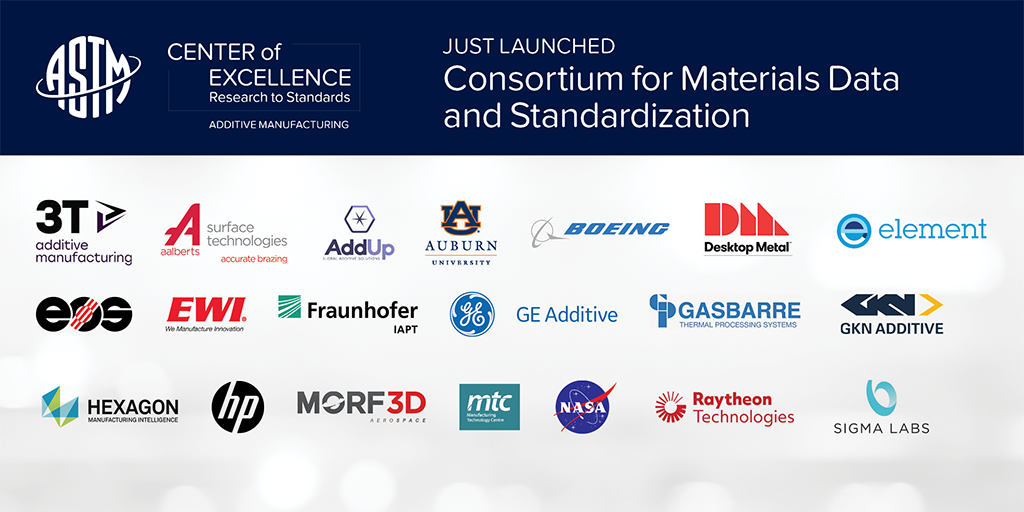ASTM International, and its international membership of volunteer technical experts, work to develop and integrate standards in an effort to improve public health and safety and consumer confidence. That’s why ASTM founded its Additive Manufacturing Center of Excellence (AM CoE) back in 2018—its academia, industry, and government partners lead R&D efforts to speed up the development and adoption of additive manufacturing, and by supporting standardization and certification, providing market intelligence and business strategy, coming up with training and certification programs, and offering advisory services via Wohlers Associates. Now, just before RAPID + TCT 2022 kicks off in Detroit, the AM CoE and its founding members have announced the formal launch of the Consortium for Materials Data and Standardization (CMDS).
“Consortia for Materials Data & Standardization (CMDS) enables companies of all sizes from across the entire additive manufacturing ecosystem to collaborate on standardizing the best practices for materials data generation and creating, curating, and managing the data needed to accelerate the industrialization and full adoption of AM technologies,” the CMDS website states.
The initiative will aim to join together leading organizations from many different industries that represent the full AM value stream, in order to work on standardizing the requirements for generating data on AM materials. Additionally, the members of this newly formed consortium will develop and manage reference datasets, like the one shown below for powder bed fusion (PBF) 3D printing, that will help speed up the qualification, and ultimate adoption, of additive manufacturing.
In addition to ASTM International, the other AM CoE partners that will support the execution and main actions of the member-driven consortium are NASA and Auburn University. There are 21 founding members of the CMDS initiative, including Auburn University, Desktop Metal, Raytheon Technologies, Sigma Labs, AddUp, GE Additive, and Boeing. These members are obviously industry experts in their own right, and will work together to ensure access to these important material datasets, as well as shore up the AM CoE’s main mission of research to standards (R2S) filling standardization gaps.
“This initiative connects industry, academia, and government teams to accelerate the path for additive adoption, moving additive manufacturing from a process with significant financial barriers to a standard manufacturing process for widespread use. Raytheon Technologies is bringing their experience and diverse research and data to help create the standards and necessary qualification methods,” stated Jeff Shubrooks, Raytheon Missiles and Defense Additive Manufacturing Technology Area Lead.
The main focus of the CDMS will be developing important process-structure-property relationships needed to create new methods of, as ASTM explains, generating “machine agnostic materials data.” Consortium partners will organize a database of quality material data, which will be available to all members so they can develop the necessary data analytics to support fast qualification of new AM materials and applications; create tools like probabilistic and physics-based models; and ensure real-time quality assurance for scaling 3D printing.
“GE Additive is pleased to continue its engagement with the AM CoE Industry Consortium. As a company that offers the entire additive ecosystem, from feedstock to finished parts, we recognize the importance of developing highly pedigreed materials property datasets,” explained Amber Andreaco, section manager – materials & powders, GE Additive. “By coming together to define a common approach to materials characterization, we hope to drive further understanding and expansion of the additive industry as a whole.”
CMDS members, with necessary input from regulatory bodies and other government agencies, will also set up requirements and best practices for creating AM material datasets by determining sources of variability and quantifying the sensitivities, and by establishing guidelines that can be used to appraise the pedigree and quality of existing material datasets. The consortium will also pick interesting materials, and certain properties, such as thermal, corrosion, and static, that make the materials good for specific applications, and carry out projects that are supportive of developing these datasets and standards.
Members of the CMDS will maintain a secure, members-only Data Management System, which optimizes the material data generation workflow that incorporates Common Data Dictionary, Data Exchange Formats, and Pedigree standards. Members have exclusive use of the material datasets developed as part of the initiative, but in exchange, they will need to share lessons learned and research results with related ASTM committees, such as the F42 subcommittee for additive manufacturing, in order to inform new AM specifications and standards. Sharing information like this can only help our industry, as it keeps everything consistent and up to date.
To learn more about the new Consortium for Materials Data and Standardization, check out the website, or visit ASTM’s AM CoE at RAPID this week in Booth #2113.
Subscribe to Our Email Newsletter
Stay up-to-date on all the latest news from the 3D printing industry and receive information and offers from third party vendors.
Print Services
Upload your 3D Models and get them printed quickly and efficiently.
You May Also Like
U.S. Navy Lab Uses 3D Printing to Reduce Tooling Lead Time By Over 90%
The F-35 Lightning II Joint Program Office (JPO), responsible for life-cycle management of the key fifth-generation joint strike fighter (JSF) system used by the U.S., its allies, and its partners,...
Etsy Design Rule Change Reduces Selection of 3D Printed Goods
Online marketplace Etsy has implemented a rule change requiring all 3D printed goods on the site to be original designs. The update to the site’s Creativity Standards states, ¨Items produced using...
Honeywell Qualifies 6K Additive’s Nickel 718 for 3D Printed Aerospace & Defense Parts
6K Additive is renowned for manufacturing sustainable additive manufacturing (AM) powder, and offers a wide portfolio of premium metal and alloy powders that include titanium, copper, stainless steel, and nickel,...
MetalWorm Sells WAAM Systems to Research Institutes in Brazil and Malaysia
Turkish WAAM firm MetalWorm has sold a system in Malaysia and another in Brazil. This is an excellent example of a few emerging trends in additive. Firstly, WAAM was experimented...




































